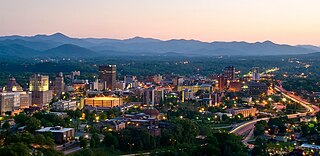
Asheville is a city in and the county seat of Buncombe County, North Carolina, United States. Located at the confluence of the French Broad and Swannanoa rivers, it is the most populous city in Western North Carolina, and the state's 11th-most-populous city. According to the 2020 census, the city's population was 94,589, up from 83,393 in the 2010 census. It is the principal city in the three-county Asheville metropolitan area, which had an estimated population of 417,202 in 2023.

Bent Creek is a census-designated place (CDP) in Buncombe County, North Carolina, United States. The population was 1,287 at the 2010 census. The Bent Creek area has mountain bike trails within the Pisgah National Forest.

Hot Springs is a town in Madison County, North Carolina, United States. The population was 520 at the 2020 census. It is part of the Asheville metropolitan statistical area. It is situated on the Appalachian Trail and French Broad River near the North Carolina-Tennessee border. Hot Springs is best known for its hiking trails, natural springs, and mountain town atmosphere.

Biltmore Estate is a historic house museum and tourist attraction in Asheville, North Carolina. Biltmore House, the main residence, is a Châteauesque-style mansion built for George Washington Vanderbilt II between 1889 and 1895 and is the largest privately owned house in the United States, at 178,926 sq ft (16,622.8 m2) of floor space and 135,280 sq ft (12,568 m2) of living area. Still owned by George Vanderbilt's descendants, it remains one of the most prominent examples of Gilded Age mansions.

Tench Coxe was an American political economist and a delegate for Pennsylvania to the Continental Congress in 1788–1789. He wrote under the pseudonym "A Pennsylvanian," and was known to his political enemies as "Mr. Facing Bothways."

WWNC is a commercial AM radio station in Asheville, North Carolina. It broadcasts a news/talk radio format and is owned by iHeartMedia, Inc. The studios and transmitter are on Summerlin Road in Ashville.

Interstate 240 (I-240) is a 9.1-mile-long (14.6 km) Interstate Highway loop in the US state of North Carolina. It serves as an urban connector for Asheville and runs in a semicircle around the north of the city's downtown district between exits 53B and 46B of I-40. Between those points, I-40 continues in an east–west direction further south of the city, roughly parallel to the Swannanoa and French Broad rivers. The western segment of I-240 is now being cosigned with I-26 as part of a larger project extending I-26 from its former western terminus at I-40/I-240 to U.S. Highway 23 (US 23) near Kingsport, Tennessee. However, NCDOT officially identifies this part of I-26 as Future 26.

Long Island, also known as Long Island of the Holston, is an island in the Holston River at Kingsport in East Tennessee. Important in regional history since pre-colonial times, the island is listed on the National Register of Historic Places and is designated as a U.S. National Historic Landmark District.

The Omni Grove Park is a historical resort hotel on the western-facing slope of Sunset Mountain within the Blue Ridge Mountains, in Asheville, North Carolina. This hotel was visited by various Presidents of the United States mentioned below.

William Lee Stoddart (1868–1940) was an architect who designed urban hotels in the Eastern United States. Although he was born in Tenafly, New Jersey, most of his commissions were in the South. He maintained offices in Atlanta and New York City.

The Jackson Building is a 140 ft (43m) 15-story building in downtown Asheville, North Carolina, which was completed in 1924 in Pack Square. It was the first skyscraper in western North Carolina.

The Bon Marché Building of Asheville, North Carolina, now the Haywood Park Hotel, was built in 1923 by E.W. Grove for the store's owner, Solomon Lipinsky. This was several years before Grove began construction on nearby Grove Arcade, one of Asheville's most famous architectural landmarks. The Bon Marché building was designed by W.L. Stoddart, a hotel architect who also designed the Battery Park Hotel and Vanderbilt Hotel.
Richard Sharp Smith was an English-born American architect, noted for his association with George W. Vanderbilt's Biltmore Estate and Asheville, North Carolina. Smith worked for some of America's important architectural firms of the late 19th century—Richard Morris Hunt, Bradford Lee Gilbert, and Reid & Reid—before establishing his practice in Asheville. His most significant body of work is in Asheville and Western North Carolina, including dozens of buildings that are listed on the National Register of Historic Places or are contributing structures to National Register Historic Districts.
Colonel Daniel Coxe IV (1673–1739), son of Dr. Daniel Coxe, went to his father's North American lands. He lived in the American colonies from 1702 to 1716 and from 1725 until his death in 1739. After returning to England in 1716, he published an account in 1722 of his travels and a description of the area encompassed by his father's claim, entitled A Description of the English Province of Carolana, by the Spaniards called Florida, And by the French La Louisiane.

The Grove Arcade, also known as the Arcade Building, is a historic commercial and residential building in Asheville, North Carolina, in its downtown historic district. It was built from 1926 to 1929, and is a Tudor Revival and Late Gothic Revival style building consisting of two stacked blocks. The lower block is a rectangular slab with rounded corners; it is capped by the second block, a two-tier set-back story.

Biltmore Industries, Inc., also known as Biltmore Homespun Shops, is a historic industrial complex located adjacent to the Omni Grove Park Inn in Asheville, Buncombe County, North Carolina, now known as Grovewood Village. Biltmore Industries was started by Eleanor Vance and Charlotte Yale, missionaries who moved to Asheville, NC in 1901. The complex of seven buildings were built about 1917 by Fred Loring Seely, and are constructed of hollow ceramic tile with stuccoed exterior wall surfaces. The buildings are The Eleanor Vance Building (1917), Charlotte Yale Building (1917), Carding and Spinning Building (1917), (Former) Weavers' Building (1923), Boiler House (1917), Gatehouse, and Guardhouse (1917). The complex produced high-quality crafts and fine hand-woven wool cloth. The property was listed on the National Register of Historic Places in 1980.
The following is a timeline of the history of the city of Asheville, North Carolina, USA.

Edward Walton Pearson, Sr. was an African-American entrepreneur, Buffalo Soldier and Spanish–American War veteran, civil rights leader and pioneering sports enthusiast. He moved to Asheville, North Carolina, in 1906, where he became known as the "Black Mayor of West Asheville" because of his influence in African-American neighborhood development and community life.

The Flatiron Building on Battery Park Avenue in Asheville, North Carolina was completed in 1927. The nine-story 52,000-square-foot building was designed by New York City architect Albert C. Wirth and built by L. B. Jackson Builders of Asheville. It is a contributing building to the Downtown Asheville Historic District.
Beaver Lake is a freshwater lake in Asheville, Buncombe County, North Carolina. The community of Lakeview Park, which was built around Beaver Lake, is now a subdivision of Asheville.




















